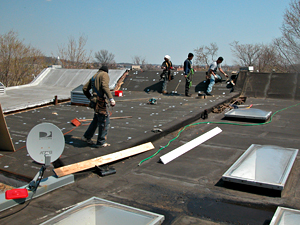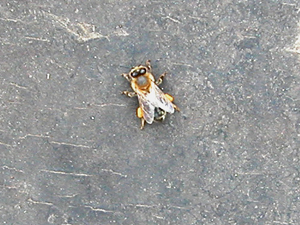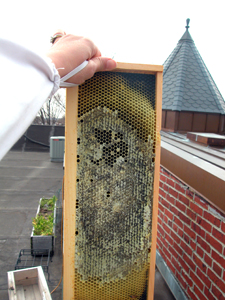 Let's review, shall we?
Let's review, shall we? I'm in the city, I want to keep bees, and I want to annoy (and become known to) as few people as possible. Therefore, my bees are on a roof deck, and the only people who should be able to see me up there are the folks in an apartment house about a block away (who should not care) and some people with a roof deck just around the corner, whom I avoid.
So in less than a year, BOTH neighbors have their entire roof decks replaced, and it's not just the supporting joists that get exposed. My northside neighbor had told me that roofers would be coming, supposedly two weeks ago, and that she would call me the night before "so I would not be alarmed by the noise." I wondered then if she already knew, but I got information from the BeeSource folks about how to block the girls in (safely) for a day, so I figured all would be well.
But today the roofers arrived without warning, and so they get to see my girls in action! I decided to ask them if I could take their picture, and they said yes, and that was probably a good thing. As I was standing there, bees were bumping into my head and buzzing all around me on their way in and out, and I was barefoot. If a crazy yuppie woman showed so little fear, it appeared as if the macho factor was gonna keep these guys from objecting!
It's probably a good thing that just yesterday, ahead of a short drizzly rain, I did my interim check on the girls. I have hung back for the past two weeks, in part to try to gain perspective and calm down, and in part to allow them to recuperate from my many disruptions. This is the time of year to be careful about food stores, and to apply any Spring varroa mite treatments, and to decide whether any surplus stored honey should be removed in advance of the Spring nectar flow. So I just popped the covers and pulled the bottom boards for an in-progress scan.
 This girl was hanging out nearby as I lit my smoker, so it seemed like she wanted to pose with her sporty pollen packs. Those little yellow cuffs on her legs, near the ends of her wings, are probably maple pollen, and she seemed kind of heavily laden and taking a break. After a couple of pictures (the others were out of focus) she flew home.
This girl was hanging out nearby as I lit my smoker, so it seemed like she wanted to pose with her sporty pollen packs. Those little yellow cuffs on her legs, near the ends of her wings, are probably maple pollen, and she seemed kind of heavily laden and taking a break. After a couple of pictures (the others were out of focus) she flew home.The Wilde colony got the first check. When I popped the top, a wave of warmth and sweet smell reached me. The girls are definitely raising brood in there, and keeping the temps high for the bees to be.
 The Wilde girls still have a decent amount of food, and the frame picture at right seems to indicate that they are sort of pecking away at their honey stores, and maybe bringing in a bit of the nectar that is now available in the wild. MaryEllen says that the bees prefer fresh nectar – that the honey they store is about as appealing as canned veggies are to us, and I suppose that it could get old after 4 or 5 months of winter – and that they will ignore honey when flower juice is available. The pattern on this comb seems to show that sometimes they eat fresh, and sometimes they are still plugging away at the comb honey. There seemed to be enough honey to support this pattern for a while, and the weather is supposed to continue in a pro-bee fashion this week, so I closed up and left them alone.
The Wilde girls still have a decent amount of food, and the frame picture at right seems to indicate that they are sort of pecking away at their honey stores, and maybe bringing in a bit of the nectar that is now available in the wild. MaryEllen says that the bees prefer fresh nectar – that the honey they store is about as appealing as canned veggies are to us, and I suppose that it could get old after 4 or 5 months of winter – and that they will ignore honey when flower juice is available. The pattern on this comb seems to show that sometimes they eat fresh, and sometimes they are still plugging away at the comb honey. There seemed to be enough honey to support this pattern for a while, and the weather is supposed to continue in a pro-bee fashion this week, so I closed up and left them alone.The Twain hive seemed a better candidate for extracting, based on the fact that I left them over 100 pounds of honey this winter, and the first deep frame I pulled was still full of honey. Toward the center of the deep box, however, I found that the cluster had moved into the bottom part of the middle frames: they might not need all this honey, but they'd probably be wanting some. So I decided to let it ride here, too. I moved the full frame to the middle (it's safer to move honey frames around than brood comb), took off the hive top feeder for cleaning, and closed it up.
For the past two Fridays, without telling you, I have been restarting the oxalic mite treatments because there are still several workers with deformed wings appearing each day, and the temperatures have been too low to use ApiLife Var. When I pulled the bottom boards, it does seem like the mite drop is receding, but the virus itself might not need the mites anymore if enough bees are transmitting it directly. Who knows? They say that the worst sign is if drones emerge with deformed wings – they are supposed to have greater resistance – and I have not seen any of them. I can only take what care is available, and be gentle.
Finally, with the Spring have come a number of invitations to place bees in new locations, including a monastery a bit over 3 miles (a perfect distance) from my roof. MaryEllen and I are collaborating on yet another bee project at a public historical park in the suburbs, and we gave a presentation to the other volunteers there not long ago. We'll make all this the subject of another post, since this one is so long.
Finally, I am sorry for the gap in posting, for those of you who wonder about such things. There has been a death in my family, not a terribly happy family, and I sometimes wonder if my love for the bees and their tight and collaborative world has anything to do with these long-past heartaches. Nonetheless, I've been in a pointlessly thoughtful fog, and welcome the needs and rhythms of the bees to bring me back to the world of the real and the alive.
2 comments:
I look forward to reading your blog every week. It is one of the best on the net. Especially interesting are the photos and your comments about the world around you. A friend and I also have started a blog called firstbees.blogspot.com to document our misadventures in beekeeping, but to be honest, it is not as good as yours. I’d be interested in exchanging some honey with you at some point. I loved the post about you and hour husband collecting from various parts of the world. Thanks for creating the gold standard in bee blogs.
Glad to hear all seems well except those pesky mites!
Post a Comment